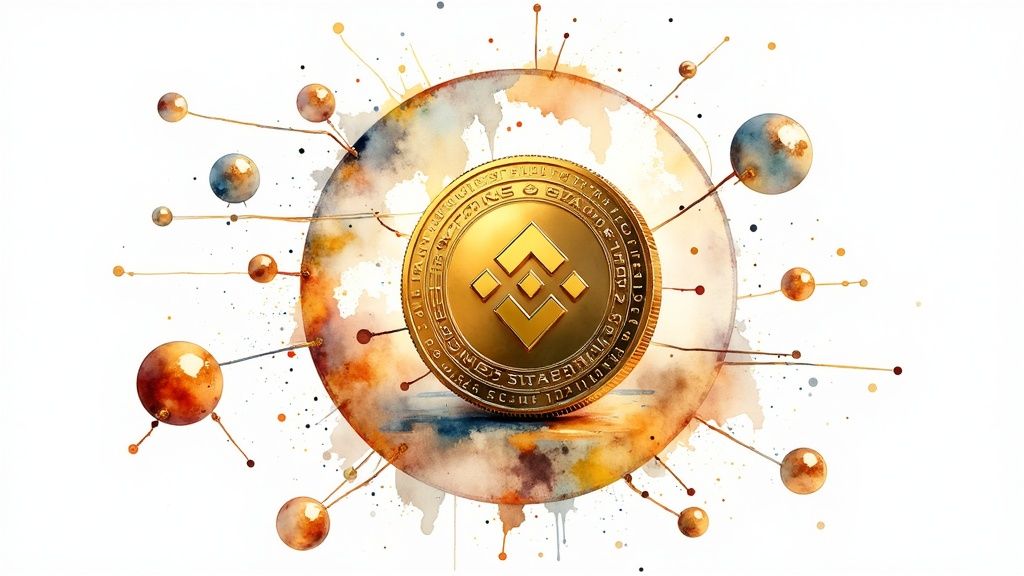



The cryptocurrency market continues to evolve and capture mainstream attention, with new digital assets emerging regularly. This growth has expanded from Bitcoin's initial proof-of-concept to a $2+ trillion market encompassing diverse projects across decentralized finance (DeFi), NFTs, and beyond. Understanding key market drivers and technology fundamentals is essential for anyone interested in this space.
Several critical factors determine a cryptocurrency's potential success and adoption - its technical architecture, real-world utility, community engagement, and regulatory status. Market analysis requires examining these elements alongside historical patterns in price movements, technological milestones, and policy developments. This comprehensive view helps distinguish between short-term hype and projects with lasting value.
This guide examines the top trending cryptocurrencies of 2023, providing detailed insights into their unique attributes, advantages, risks, and market impact. Whether you're an active trader, blockchain developer, or curious observer, you'll gain practical knowledge about the digital currencies driving innovation in modern finance. Let's explore the projects that are defining the next phase of cryptocurrency evolution and reshaping traditional financial systems.

Bitcoin (BTC) emerged in 2009 through the work of Satoshi Nakamoto, establishing itself as the first cryptocurrency. Its introduction represented a major shift by creating a decentralized digital currency that operates without oversight from banks or governments. Bitcoin maintains its position at the top of cryptocurrency rankings due to its historical importance, broad adoption, and market influence. The system uses blockchain technology to create a transparent, distributed ledger that records all transactions across a network of peers.
Several key features define Bitcoin's value proposition. The fixed supply cap of 21 million coins creates natural scarcity, leading many to view it as "digital gold." This limited supply, combined with growing institutional and retail adoption, helps drive market demand. The network employs Proof-of-Work (PoW) consensus to validate transactions and maintain security, though this process requires significant computational resources. While transactions are pseudonymous, the public nature of the blockchain enables full auditability.
Bitcoin's development from an experimental project to a globally recognized asset includes notable milestones. Major corporate investments like Tesla's $1.5 billion Bitcoin purchase and El Salvador's adoption as legal tender mark key steps toward mainstream acceptance. Integration with established payment platforms like PayPal has increased accessibility. However, technical limitations affecting transaction speed and costs during high-volume periods remain ongoing challenges. The energy requirements of PoW mining also face environmental scrutiny.
Pros:
Cons:
Tips for Bitcoin Investors:
Key figures like Michael Saylor, Jack Dorsey, and Elon Musk have shaped Bitcoin's trajectory through their public support and investments. Their involvement has helped drive mainstream interest and adoption. For more context on cryptocurrency developments, see: Crypto Coin Trends: How Digital Currency is Reshaping the Future of Finance. Understanding Bitcoin's core features, history, and ongoing debates around its strengths and limitations remains essential for anyone exploring digital assets.

Ethereum stands out as a key cryptocurrency not only for its market value but also for introducing smart contract capabilities and decentralized applications (dApps). Beyond basic transactions, Ethereum provides a programmable blockchain platform that enables developers to create complex applications. This foundation supports both decentralized finance (DeFi) and non-fungible tokens (NFTs), with ETH serving as the essential fuel for transactions and contract execution.
The platform's smart contracts automatically execute agreements between parties without intermediaries, improving efficiency and transparency across industries from supply chain to identity verification. The ERC-20 standard has enabled thousands of new tokens to emerge, each serving specific purposes within the ecosystem.
A major advancement came with Ethereum's shift from Proof-of-Work to Proof-of-Stake, significantly reducing energy usage while preparing for better scalability and lower fees.
Pros:
Cons:
Examples:
Tips:
Created by Vitalik Buterin, Joseph Lubin, and Gavin Wood, Ethereum has grown from concept to cornerstone of blockchain innovation. Despite ongoing challenges, its strong development community and continuous improvements maintain its position as a fundamental force in cryptocurrency. Understanding Ethereum's capabilities and limitations remains essential for anyone involved in decentralized technology.
Solana (SOL) is distinguished by its focus on processing speed and throughput capacity. The platform combines Proof-of-History (PoH) with Proof-of-Stake (PoS) consensus mechanisms, enabling up to 65,000 transactions per second (TPS) at much lower costs than networks like Ethereum.
The PoH system adds timestamps to transactions, creating a verifiable record that optimizes consensus. When paired with PoS, validators can process transactions efficiently. The platform supports smart contracts, enabling developers to build decentralized applications (dApps) and DeFi protocols.
Solana's growth correlates with increasing demand for blockchains that handle high transaction volumes. Its minimal fees and quick confirmations drew both developers and users, leading to broad ecosystem adoption. While the FTX exchange bankruptcy impacted Solana's trajectory, the founding team led by Anatoly Yakovenko and Raj Gokal continues advancing the technology and community.
The platform powers real-world use cases like the Serum decentralized exchange (DEX) which relies on Solana's speed for trading. Multiple NFT marketplaces also operate on Solana, offering cost-effective minting and trading. Despite FTX's collapse affecting sentiment, the network maintains appeal for those prioritizing performance.
Pros:
Cons:
Tips for using Solana:
While network stability remains an ongoing focus, Solana's technical capabilities and expanding ecosystem position it as a significant blockchain platform. The balance of high performance against occasional disruptions requires careful evaluation by potential investors and users seeking fast, affordable transactions.

Binance Coin (BNB) has established itself as a major cryptocurrency due to its essential role in the Binance ecosystem and consistent growth. BNB started in 2017 as an ERC-20 token for trading fee discounts on Binance, but has since expanded to become the native asset of Binance Chain and Binance Smart Chain (BSC), powering an extensive decentralized network.
The primary value of BNB comes from its practical applications within Binance's ecosystem. Users can apply BNB to reduce trading fees, participate in token sales through Binance Launchpad, make payments across the platform, and cover transaction costs on BSC. This broad range of uses creates ongoing demand for the token.
The rise of Binance Smart Chain marked a key milestone for BNB adoption. By providing a more cost-effective platform for decentralized apps compared to Ethereum, BSC drew significant developer activity. Major projects like PancakeSwap showcase BNB's real-world utility. The integration with Trust Wallet has also improved BNB's accessibility.
Features:
Pros:
Cons:
Tips for Implementation:
Popularized By: Changpeng Zhao (CZ), CEO of Binance
BNB's practical applications, growing BSC ecosystem, and systematic token burns make it an important asset to watch. However, investors should weigh the centralization aspects and regulatory considerations tied to Binance's influence.
Cardano operates as a research-based blockchain platform focused on delivering reliable, secure solutions through an academic approach. Building upon peer-reviewed research and careful development practices, Cardano aims to create a stable foundation for blockchain applications. This thoughtful strategy makes it a noteworthy player among trending cryptocurrencies, particularly for those seeking technically-sound projects. (cardano.org)
The platform employs a dual-layer architecture - one layer manages ADA transactions while another handles smart contracts. This split design enables independent updates and better scalability. At its core, the Ouroboros consensus mechanism stands out for its energy-efficient approach to blockchain validation, directly addressing common criticisms of high energy consumption in cryptocurrency networks.
Key aspects of Cardano's framework include:
Advantages:
Limitations:
Current Applications:
The platform's growth stems from leadership by Charles Hoskinson, Ethereum co-founder, alongside dedicated development organizations IOHK and Emurgo. Its focus on academic research appeals to investors seeking technically-sound projects.
Practical Tips:
Cardano's research-driven approach and focus on technical excellence position it as a significant blockchain platform. While development takes time, this reflects a commitment to building reliable systems. The platform offers value for those prioritizing technical merit and long-term stability over rapid deployment.
Polkadot (DOT) stands out for solving a critical problem in blockchain - the inability of different networks to communicate effectively. By enabling seamless interaction between blockchains, Polkadot creates an environment where diverse networks can share data and functionality, opening new possibilities for decentralized applications.
The platform uses a unique two-layer structure: a core "Relay Chain" that handles security and consensus, combined with specialized "Parachains" that run in parallel. Each Parachain can be customized for specific use cases while still benefiting from the shared security of the main network. This design supports both scalability and specialization.
Key Features and Benefits:
Real-World Examples and Case Studies:
Several projects show how Polkadot works in practice:
Evolution and Popularity:
Created by blockchain experts Gavin Wood, Peter Czaban, and Robert Habermeier, Polkadot went live in 2020. Its solid technical foundation and focus on blockchain connectivity have drawn significant developer and investor interest.
Pros and Cons:
| Pros | Cons |
|---|---|
| Scalable architecture | Complex technology stack |
| Strong technical foundation | High initial investment for parachains |
| Flexible upgrade process | Competition from other interoperability solutions |
| Cross-chain compatibility | Learning curve for developers |
Practical Tips for Implementation:
Website: Polkadot Network
Polkadot's focus on connecting different blockchains and its robust technical architecture make it a significant player in cryptocurrency. While technical challenges exist, its engaged community and effective design suggest continued momentum in blockchain development.

Ripple stands out in the cryptocurrency market through its focus on enabling fast, low-cost international money transfers for institutions. The platform uses a digital payment protocol and cryptocurrency built on the RippleNet network. This infrastructure connects banks and payment providers to facilitate efficient cross-border transactions. The emphasis on serving financial institutions sets XRP apart from other cryptocurrencies.
One of XRP's key strengths is its exceptional transaction speed. With an average processing time of 3-5 seconds, it significantly outperforms traditional cross-border payment systems that can take several days. The minimal transaction fees make XRP an appealing alternative to existing solutions like SWIFT. RippleNet's design specifically caters to financial institutions, making international transactions more seamless.
Real applications demonstrate XRP's practical value. Major institutions like MoneyGram use RippleNet for cross-border payments, while Santander implemented the technology in their One Pay FX service. SBI Remittance Service employs RippleNet to improve their international transfer services. These partnerships validate Ripple's technology and showcase its growing acceptance in mainstream finance.
The platform's success stems from addressing specific challenges in institutional finance. While other cryptocurrencies target individual users, Ripple identified and solved inefficiencies in cross-border payments. This focused strategy has gained attention from banks seeking better payment solutions. Industry leaders Brad Garlinghouse, Chris Larsen, and David Schwartz have played key roles in advancing Ripple's adoption.
The ongoing lawsuit with the U.S. Securities and Exchange Commission (SEC) presents a significant challenge for Ripple. This legal uncertainty affects XRP's market performance and investor confidence. Critics also question Ripple's centralized structure and pre-mined token supply, contrasting it with more decentralized cryptocurrencies.
Pros:
Cons:
Tips for Investors:
For detailed information, visit Ripple's official website.
Despite current challenges, Ripple's impact on cross-border payments and growing institutional adoption support its position among leading cryptocurrencies. The potential to reshape traditional finance remains significant, though the SEC case outcome will greatly influence its future. Investors should carefully evaluate both opportunities and risks before making investment choices.
Dogecoin (DOGE) stands as an intriguing example of how a cryptocurrency created as a joke can gain significant market presence. What started in 2013 as Billy Markus and Jackson Palmer's parody of Bitcoin has evolved into a notable digital currency with real-world applications and a dedicated following.
The project's success stems largely from its approachable nature and active community. Dogecoin's accessible premise and welcoming culture have made it an entry point for many cryptocurrency newcomers. High-profile endorsements, particularly from Elon Musk, have further cemented its place in mainstream consciousness.
Key Technical Aspects:
The coin operates on the Scrypt algorithm, enabling:
Notable Strengths:
Key Challenges:
Real Applications:
Practical Usage Tips:
Key Contributors: Elon Musk, Billy Markus, Jackson Palmer
While Dogecoin may not push technical boundaries, its impact on cryptocurrency adoption is significant. The combination of an active community, practical usability, and growing merchant acceptance maintains its relevance. However, potential users should carefully consider both opportunities and risks, particularly regarding the unlimited supply and market volatility.
Chainlink (LINK) represents a foundational layer of infrastructure within decentralized finance (DeFi). As a decentralized oracle network, it enables smart contracts on blockchains like Ethereum to securely access real-world data and external systems. This capability to bridge on-chain and off-chain environments is fundamental for DeFi applications, from lending platforms to insurance protocols.
The system operates through a network of independent node operators that collect data from various external sources and deliver it to smart contracts in a secure, tamper-proof way. This decentralized architecture eliminates single points of failure and improves overall system reliability. Key components include decentralized price feeds, cross-chain interoperability, and a robust network of node operators.
The project's success stems from several factors: it was first to market in the oracle space, formed strategic partnerships with companies like Google Cloud, and achieved extensive DeFi integration. Real-world applications showcase its utility - Aave uses Chainlink for real-time asset price data, while Synthetix relies on it for synthetic asset pricing. Insurance protocols also depend on Chainlink to verify real-world events for claims processing.
Despite its advantages, Chainlink faces certain challenges. The LINK token experiences price volatility common to crypto assets. New oracle solutions continue to emerge as competitors. The project's tokenomics structure and operational costs require careful consideration.
Pros:
Cons:
Tips for Investors and Developers:
Created by Sergey Nazarov and Steve Ellis, Chainlink has proven its value by addressing a critical need in the DeFi sector - connecting smart contracts with external data. This solution enables countless blockchain applications to interact with real-world systems and information. For deeper insights, visit the Chainlink website.
Polygon (MATIC) has emerged as a leading Layer-2 scaling solution for Ethereum by addressing key network challenges around speed and cost. By enabling faster and cheaper transactions while maintaining security and compatibility with Ethereum, Polygon has become essential infrastructure for developers and users. Visit Polygon's Website
At its core, Polygon reduces Ethereum's network congestion and high gas fees through multiple scaling approaches including Plasma chains, zk-rollups, and optimistic rollups. This allows developers to either port existing Ethereum applications or build new ones that benefit from Polygon's performance advantages while still leveraging Ethereum's security model.
Key Features:
Notable Implementations:
Real-world adoption shows Polygon's practical impact:
Project Background:
Founded by Sandeep Nailwal, Jaynti Kanani, and Mihailo Bjelic, Polygon began as Matic Network focused on Plasma scaling. The project expanded its scope to include multiple scaling solutions, leading to the Polygon rebrand. Growing demand for Ethereum scaling has driven widespread adoption among developers seeking efficient blockchain infrastructure.
Advantages and Limitations:
Benefits:
Challenges:
Usage Guidelines:
Polygon (MATIC) stands out for its solid fundamentals, expanding ecosystem, and crucial role in making Ethereum more accessible. Its ability to process transactions efficiently and affordably makes it valuable for developers building applications and users seeking low-cost blockchain interactions. The platform's growing adoption in DeFi and consistent technical progress warrant attention from traders and analysts examining the crypto market's evolution.
| Cryptocurrency | Implementation Complexity 🔄 | Resource Requirements ⚡ | Expected Outcomes 📊 | Ideal Use Cases 💡 | Key Advantages ⭐ |
|---|---|---|---|---|---|
| Bitcoin (BTC) | Moderate | High (energy intensive) | Secure store of value | Digital gold, long-term holding | High liquidity, strong security |
| Ethereum (ETH) | High (due to smart contracts) | Moderate-High (gas fees) | Robust dApp & DeFi ecosystem | Smart contracts, NFTs, DeFi | Large developer community, innovation |
| Solana (SOL) | High (unique PoH mechanism) | Low (minimal fees) | Fast, high-throughput transactions | High-frequency trading, decentralized apps | Exceptional speed, cost efficiency |
| Binance Coin (BNB) | Moderate (ecosystem integration) | Low (efficient fee structure) | Enhanced trading utility | Exchange transactions, token launches | Wide utility, fee discounts |
| Cardano (ADA) | Moderate-High (peer-reviewed) | Low (energy efficient) | Sustainable, scalable blockchain | Research-driven projects, regulated markets | Strong academic foundation, transparency |
| Polkadot (DOT) | High (interoperability focus) | Moderate (staking requirements) | Multi-chain communication | Cross-chain integrations, decentralized apps | Scalable, flexible architecture |
| Ripple (XRP) | Moderate (streamlined design) | Low (minimal transaction fees) | Rapid international transfers | Banking, remittance services | Speed and established financial partnerships |
| Dogecoin (DOGE) | Low (simple design) | Very Low (minimal resource usage) | Community-driven microtransactions | Tipping and small payments | Strong social community, wide recognition |
| Chainlink (LINK) | Moderate (oracle network) | Moderate (data feed integration) | Reliable off-chain data connectivity | dApps requiring external data inputs | Critical infrastructure for DeFi |
| Polygon (MATIC) | Moderate (Layer 2 scaling solution) | Low (cost-effective transaction fees) | Enhanced Ethereum transaction speed | Scaling decentralized applications | Cost-effectiveness, rapid connectivity |
The cryptocurrency space exhibits constant change and price movement across both established and emerging digital assets. From Bitcoin and Ethereum to newer platforms like Solana and Polygon, each cryptocurrency presents distinct characteristics that require careful analysis. Success demands understanding not just technical metrics but also broader market sentiment and adoption trends. Close examination of leading cryptocurrencies reveals the critical importance of factors like technological capabilities, security measures, real-world usage, and community support.
Making sound decisions requires a balanced analytical approach. Investment strategies should be grounded in thorough technical and fundamental research rather than speculation. Portfolio diversification helps manage volatility, while staying informed about regulations and economic conditions provides essential context. While technical indicators and sentiment data offer valuable signals, they must be evaluated within the complete market picture.
Ongoing education is fundamental as the cryptocurrency landscape continues developing. Key areas driving innovation include Decentralized Finance (DeFi), Non-Fungible Tokens (NFTs), and virtual world technologies. Understanding these emerging use cases and their potential influence on different cryptocurrencies enables more strategic decision-making. Successful navigation requires flexibility to adjust approaches based on changing conditions and new information.
Key Considerations:
Following cryptocurrency trends requires tools that cut through market noise to deliver actionable intelligence. Coindive provides comprehensive features including real-time social metrics, AI-enabled price notifications with market context, and customizable alerts for major developments. Our platform helps you identify meaningful patterns, understand market movements, and make data-driven choices. Experience enhanced cryptocurrency tracking capabilities - visit Coindive to learn more.